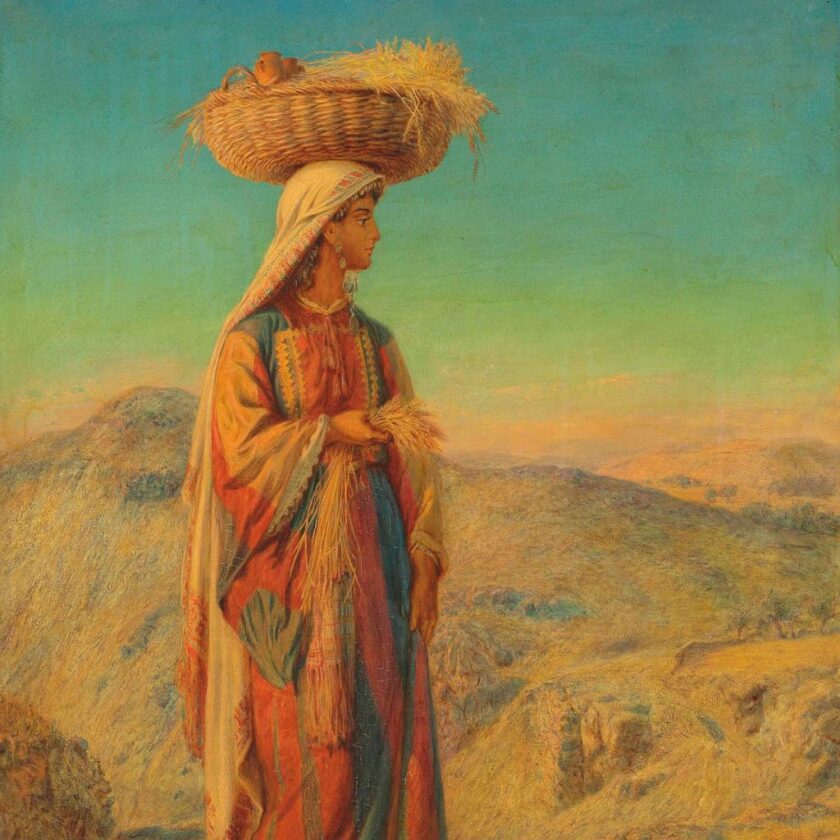

May 30 - June 5
Albrecht Durer (1471-1528),
Samson Rending a Lion, no date, woodcut, 14 7/8 x 10 15/16 inches. Brigham Young University Museum of Art, purchase/gift of Mahonri M. Young Estate, 1959. The story of Samson is a cautionary tale. This etching by Albrecht Dürer uses unprecedented, striking tonal gradations and complex lines to convey Samson’s ferocious strength, which God used repeatedly to deliver his people from their enemies. Nevertheless, when Samson forgot the true source of his power, that strength failed him. Samson’s strength was not his own, but a purposeful gift from the Lord. What is a gift you have been given, and how can it bless others?


June 6 - 12
William James Webbe (1853-1878),
Ruth: An Eastern Gleaner, No date, Oil on canvas, 29 1/2 x 23 1/4 inches. Brigham Young University Museum of Art, purchased with funds provided by Amy T. Barker, 2016. Ruth, a foreigner who married into the house of Israel, is noted in scripture for her great kindness, patience, faith, and loyalty to both her family and newfound religion despite great -personal tragedy. Though gleaners are often depicted as tired and even dirty from their labor, here she is portrayed dressed in bright colors as she looks out over the field in which she works. What qualities do you think the artist is trying to portray in this depiction of Ruth?


June 13 - 19
James Jacques Joseph Tissot (1836-1902), A. de Parys (1886-1931),
David Slings the Stone, c. 1896-1904, gouache on board, 10 1/5 x 6 1/2 in, The Jewish Museum, New York. Image provided by the Jewish Museum, New York. Gift of the Heirs of Jacob Schiff. On display in the exhibition
Prophets, Priests, and Queens: James Tissot’s Men and Women of the Old Testament. The challenge of defeating Goliath, a giant Philistine warrior, terrified Saul and the Israelite armies. The task of defeating him fell to the youthful David, an unarmored, scarcely armed Judean shepherd dwarfed by the seasoned soldier before him. In the end, their difference in size, weaponry, and experience did not matter, for David approached the conflict “in the name of the Lord of hosts” (1 Samuel 17:45). In Tissot’s depiction of the confrontation, Goliath begins to fall backwards, seemingly over a ledge, possibly on top of his own soldiers. What “giants” have you seen fall in miraculous ways?


June 20 - 26
Mahonri M. Young (1877-1957),
Wise Old Man, 20th century, charcoal, 18 15/16 x 13 3/8 inches. Brigham Young University Museum of Art, purchase/gift of Mahonri M. Young Estate, 1959. When the Lord inquired what gift Solomon would desire from Him, the young king requested “a wise and an understanding heart” (1 Kings 3:5, 12). Wisdom is an attribute of godliness that we all can aspire to. In this sketch by Mahonri Young, “Wise Old Man,” we see a lined face with kind eyes and a knowing expression, suggesting experience, openness, and discernment. We do not know what education or training he may or may not have had, but we’re given the impression that his insights will be thoughtful and shrewd. Who are wise people in your life? What have you learned from their example? How can we develop the attribute of wisdom?